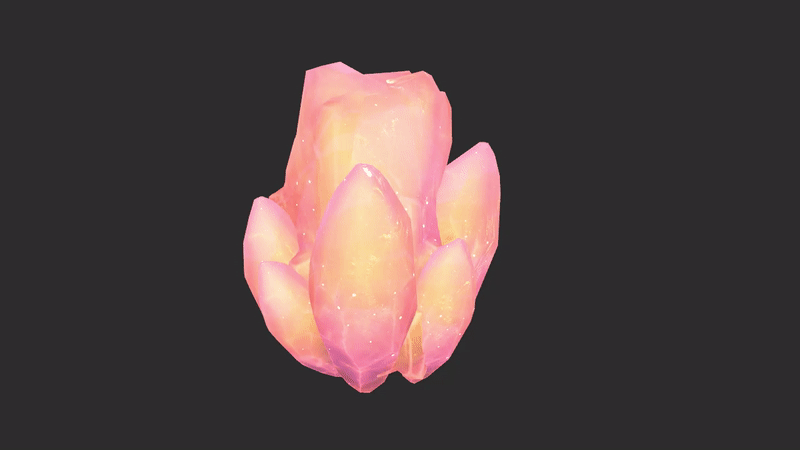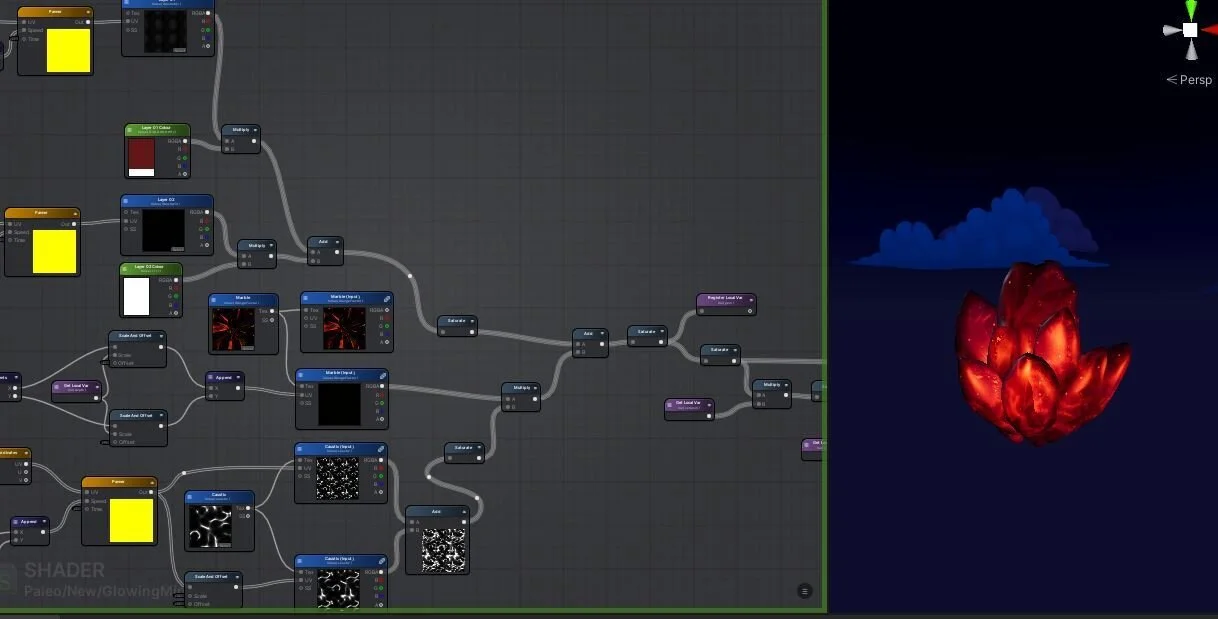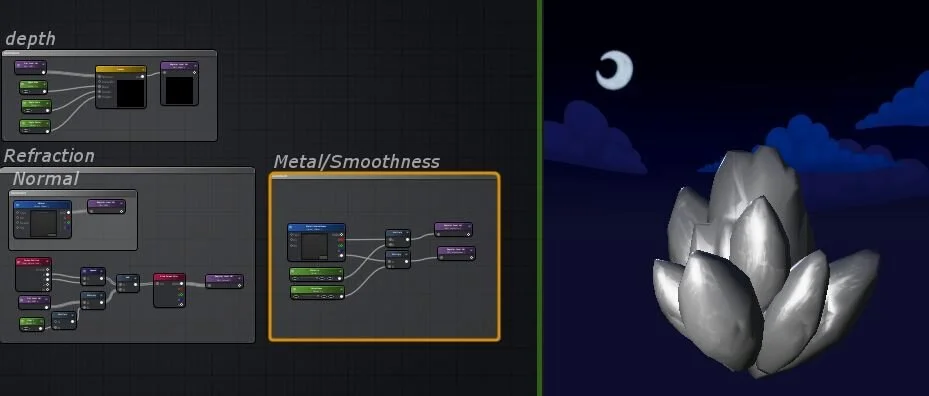Howdy ranchers, and welcome to our very first entry to Dino Diaries! Each month we’ll be diving into some development-focused blogs for you all, and of course, we had to make the title Dino themed…
We’ve been working away behind locked doors for quite some time now, and we know how eager you have been for info. We’re so excited to start bringing our community along on this development journey, starting with the most beautiful, wild, and adventurous part of the game so far… Veridian Valley!

The Veridian Valley Environment
Veridian Valley is one of the first places you find in Paleo Pines, it sits just outside your ranch. It’s taken us a while to get the Valley just right so that it’s not only a hub of the game, but an area which you will enjoy spending a lot of your time in – taming dinos, chatting to the quirky locals, or just taking in the scenery.
Unlike a devblog you may have read in the past we wanted to do ours a bit differently by doing mini interviews with key people in the studio. For Veridian Valley we chatted with environmental artist, Jakub Bojanowski, on where his inspiration for the Valley comes from.
Was there a certain feeling you wanted the Veridian Valley to convey, how did you bring this feeling to life?
When looking for inspiration, we kept mentioning that the Valley needed to have ‘a sense of wonder’, which is why I wanted to give the player many places to explore and discover on their own. Creating large open rolling hills with a lot of depth, as well as more closed off areas, allows us to guide the player around the most important points of the valley while letting them get to know the new world a little bit at a time. Paleo Pines is an incredible world that allows our players to escape, and as the first introduction to that world, we needed the Valley to feel both familiar and extraordinary at the same time. ‘Wonder’ really does sum up the feeling that I get when I’m in there now.
Are there things we should be on the lookout for while exploring the Valley?
Well obviously the roaming dinos, but every corner of the valley is packed with areas to explore. There are many collectibles all around the Valley, some are hidden, while others grow in low or high rise areas. One of the pillars of the game is exploration and discovery, so everything we’ve put into the environments provide players with a sense of anticipation – what’s around this corner? What’s behind this tree? Where does this gap in the tree lead?

What is your favourite corner of Veridian Valley?
The area around Owynn’s house is definitely my favourite, it has a lot of variety in terrain and foliage.
Did you design any areas to look like places from your childhood or parks you know?
Owynn’s house, actually! My granny had a garden full of beautiful flowers and bushes all around her house, it always felt so cozy!

Owynn’s House
In this segment, we spoke with Abigail Gelston. Abigail has been responsible for Owynn’s house from right after concept stage so is well placed to tell us all about it.
Abigail, before we talk houses, can you tell us a bit about Owynn?
Owynn is one of the first people you meet in Paleo Pines. He’s a meticulous and highly intelligent dinosaur researcher, but rather than observing dinos in the wild, he spends most of his time with his nose in books and writing volumes of research data. He’s friendly and helpful, but at times he’s a little bit nervous and scattered when visitors come around unannounced.

Can you tell us something about the process of making the concept art into a 3D model and the things you realised needed to adjust to work in-game?
Owynn’s house was modelled in Blender and textured in Substance Painter. There were multiple views drawn for the house, but I had to make sure it was a reasonable size next to Owynn’s character, so that he would be able to fit through the door and walk up the little steps. It sounds like such an obvious thing, but it’s one of those details that’s surprisingly easy to overlook.
One thing we realised early was that its design felt almost too structured and not lived in, so I tweaked the tilt of some of his wooden posts, and made the window frames a little more handmade. Most of the time was spent on the huge two willow trees, as their 2D design from front and side meant it was quite flat when initially modelled in 3D.
Once the foliage style was developed further for the game, I then updated the tree trunks with more sculpted detail and added more branches to build the silhouette to fill more surrounding space, and the foliage created is now more detailed with hand placed planes.
More detail was also carried in the house model at the later stages by Jakub, such as adding extra sculpt work on the wood grain and bevelled edges to make the corners of the house and base softer to catch the light better.

Were there things about Owynn’s personality that you had to take into account with the creation of his house?
The design behind each NPC’s house as well as its location in the level is greatly influenced by the personality of the NPC. Owynn is introverted and rarely leaves his home, so he is right beside this peaceful lake with his house almost hidden by all these huge willow trees around it. I think this helps us read that he does not want to be disturbed unless absolutely necessary!
Glowstones
In this segment we’re speaking a little bit with Abigail but also with Scott Gill, who, other than being an incredible rigger of dinos, is also responsible for working on things like shaders and textures so everything in Paleo Pines looks exactly as it should.
Glowstones are scattered all around Veridian Valley. They’re rare and special, but if you’ve got your eyes open you’re bound to stumble across one eventually.

Can you tell us a little bit about the modelling process and inspiration for these gorgeous glowstones?
The inspiration behind the glowstone’s visuals came from the friendly glow and calming properties of salt lamps and natural amethyst. You’d think that achieving a glow similar to a real-life object would be pretty simple, but it turned out to be trickier than we thought.
The glowstones went through quite a few iterations. The first sculpt of them was a mixture of salt lamps and amethyst as planned, but afterward it was decided we wanted the shapes more sharp and gem-like, though still natural in silhouette. I achieved a lot of the sharper cut edges with the flatten edge tool in Zbrush. This also meant a few stages of retopologizing and retexturing.
The glowstones were initially textured in Substance Painter with a few masks influencing a glowing shader that enhanced the cut edges and feel for them, but they started to feel like they belonged near lava, so shader adjustments were made to develop the look of these further to be more “magical”.
The final outcome mostly came down to Scott’s amazing shader work to give them that extra special feeling. In the next bit, Scott will explain how he went about the shading of the glowstones. Take it away, Scott!

ALBEDO
(base colour within the stone)
The albedo setup is what gives us that internal colour that we can use to start layering the glowing effects on top. This is also where all the movement is generated for all the rippling effects inside the stone! We use 3 different texture maps all moving at slightly different speeds added on top of one another to achieve this effect, the first map is a simple geometric pattern that constantly shifts through the stone. The second map is a colour texture with different hues. The final map is the caustic effect texture. At this stage, the glowstone looks more like a lava rock!

NORMAL/REFRACTION
(how colour and light shines through the stone’s surface)
The normal and refraction is what gives the stone its gem-like surface texture, as well as making the stone have a transparent feel. This also distorts the objects that can be seen through the gem. This is all tinted by the albedo maps so the refracted image blends with the stone.

EMISSION
(external glow)
This is what is used to make the gem appear as a constant source of light. It uses the panning textures within the albedo to generate darker/lighter areas of constant light on the gem as things move around inside. This also has a pulsing effect that adds an overall brightness to the gem over time in a triangle-like wave.

SMOOTHNESS/METAL
This is used to give the shader its outer shininess and give off those specular highlights!

Hopefully when you are in Paleo Pines you’ll realise there’s more to that glowstone than meets the eye.
And a huge thank you to you for joining us for our first Dino Diaries post. We hope you enjoyed it and stay tuned for next month when we’ll be speaking with our artists about the clothes in Paleo Pines, and we’ll bring Scott back for some water tech talk.
If you want to join the Paleo Pines family, please jump into our Discord channel, or follow us on our social channels below:
Twitter: http://www.twitter.com/PaleoPines
Instagram: http://www.instagram.com/Paleo_Pines
Facebook: http://www.facebook.com/PaleoPines
Discord: https://discord.com/invite/5mjbs6D
TikTok: @italicpig

